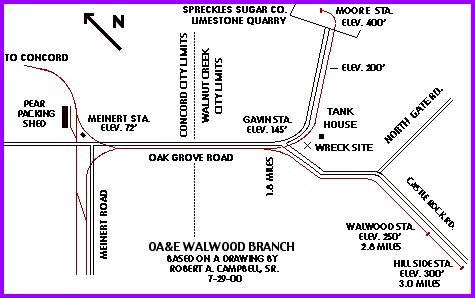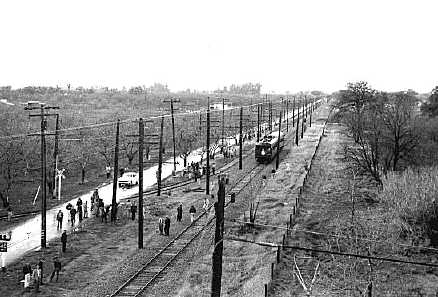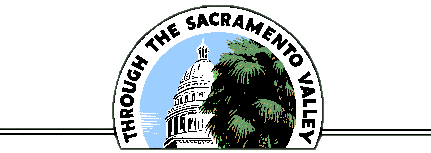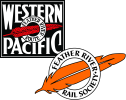THE OA&E WALWOOD BRANCH
The most obscure operation of the Oakland & Antioch Railway was the Walwood Branch, running from Meinert Station on Oak Grove Road at Meinert, 2.8 miles south to Walwood Station.
Stations on this branch were Whitman, Gavin, Moore, Walwood and Hillside. The Walwood Branch ran along the west shoulder of Oak Grove and Castle Rock county roads. I recall talking to Mr. Will Frank, who said the name Meinert came from a boy who was killed at that location in a 1908 haying accident. Other names such as Gavin and Whitman were for property owners along the route. I do not know the origin of the names for Moore and Walwood stations.

In 1874 a hotel was built on Mount Diablo called the Mountain House. It was a mile from the summit, and two roads were built to the hotel. One was from Ygnacio Valley, the Pine Canyon Stage Road, and a second road from Danville, now called Dan Cook Trail. These roads joined just a mile below the hotel. They were replaced in 1915 by North Gate and South Gate Roads.
There turned out to be many problems with the idea of transporting sightseers to Mount Diablo. All of the land on the mountain was private, primarily ranches. The ranchers objected to sightseers overrunning their land and, on occasion, starting fires. In 1891, the ranchers petitioned the County Board of Supervisors to close the mountain roads. Gates and fences kept the public out, and the hotel was burned to the ground. It was not until 1915 that a 23-mile toll road was opened to the summit. Mount Diablo State Park was dedicated in 1921.
The original intent of the branch was to run to the base of Mount Diablo where sightseers could transfer to stages for the ride to the top of the mountain. Construction of the branch started in April of 1911, and was originally called the Ignacio Valley Branch, the way Ygnacio was then spelled. A 1914 Contra Costa map shows the rail line from Meinert to North Gate Road, but not the full length to Hillside Station.
Service on the O&A Walwood Branch commenced on June 15, 1911, to Gavin Station and North Gate Road for both freight and passengers. A branch from the branch was built from Gavin to the Spreckles Sugar Company quarry at Moore Station on the west side of Lime Ridge. Limestone was shipped from here to Spreckles' sugar beet refinery south of Salinas in Monterey County. The cars were taken by the O&A to Las Juntas Station where they were transferred to the Southern Pacific's San Ramon Branch.
 During the last years of SN passenger operation, former O&A combine 1002 was restored
During the last years of SN passenger operation, former O&A combine 1002 was restoredto something like her original appearance when she worked the Walwood Branch. The Holman
car was stored at Chico when this photo was taken in 1940 during a railfan excursion.
The car was only relettered on one side, as the opposite side was in deplorable condition.
G. Graham photo; Garth G. Groff collection.
The Spreckles Sugar limestone quarry was responsible for two train wrecks on the O&A. On June 13, 1911, the CONTRA COSTA GAZETTE reported that two trainmen were seriously injured, and a third badly bruised, when a three car train derailed that afternoon. The scene of the wreck was at the foot of the grade on the branch line to the quarry. The grade was rated 6%, but the three railroad men claimed it was over 7%.
"A few minutes before two o'clock this afternoon, the train started from the quarry with the first load of rock to be hauled from that place. The train consisted of one of O&A's fine new passenger coaches, a flatcar, and a large steel gondola car. When the descent began, motorman Young applied all of the brake, but even with wheels locked and the rails sanded, the rock car with 55 tons was too great for the passenger car to hold back. The train gradually gained momentum, the men found it was running away, and at this point all three men jumped. "The train rushed down the hill with increasing speed until it reached the curve at the bottom, where it left the rails. [Note the location between Gavin Station and the tank house on the map.] All three cars were smashed, and much repair work would be required before they can return to service."
A picture of the wreck appears in Ira Swett's SACRAMENTO NORTHERN (Interurbans Special 26). The picture shows wrecked O&A car 1001 in the middle of Oak Grove Road, with the tank house in the background and a farm house to the right. The tank house still stands in the same location, but due to widening of Oak Grove Road and flood control work on Pine Creek, the farm house was moved to the left of the tank house.
As fate would have it, a second wreck happened July 6, 1911. Again according to the CONTRA COSTA GAZETTE, "At 3:05 this afternoon, the second wreck on the O&A electric occurred at the same location as the former one about three weeks ago when a train jumped the track and was badly damaged at the foot of the hill leading to Spreckles quarry. At three o'clock motor car #2 [believed to be Central California Traction Express Motor No. 2 which records indicate was leased to the O&A], having completed switching work at the quarry, started down the grade with two empty gondolas. Though the brakes were set hard and the wheels were dragging on the sanded rails, the train increased its speed and the crew realizing that another wreck was impending, jumped for their lives, escaping with a few minor cuts. At the foot of the long grade, the motor car crashed into two empty flatcars. The trucks of the motor car stayed on the rails while the body was hurled into a field. The loss to the company will be considerable, and officials are considering installing a drum and cable to ease the cars down the hill."
Not much is now known about Spreckles' quarry operations, such as was a steam shovel used, or just a horse and scraper? Were rail cars loaded from bunkers? Lime Ridge summit is 800 feet at this point, though much of the quarry operations were near the 400 foot level.

was lengthened from 45 to 56 feet in 1913, and then spent most of its life on the Pittsburg Branch.
Garth G. Groff collection.
The branch was soon extended from North Gate Road along Castle Rock Road for another half mile to Walwood Station, 2.8 miles from Meinert. According to timetables, service commenced on April 1, 1912. After 1914, the branch was again extended further to Hillside Station where another quarry existed. This made the total length of the branch's main track three miles.
Passenger service provided by the O&A consisted of cars operating from Bay Point (Port Chicago) to Lafayette in 1911 and 1912. The train would make side trips from Meinert to Walwood, and the fare anywhere along the branch was ten cents.
Later when the Oakland Antioch & Eastern took over and service from Oakland to Sacramento commenced in 1913, Concord local trains would make trips over the Walwood branch during their layover time. Train #80 from Meinert to Walwood ran between 12:25 and 12:40 p.m. Train #81 from Walwood to Meinert ran from 12:45 to 1:00 p.m. -- 15 minutes to cover 2.8 miles -- no speed record there. Train #82 ran from Meinert to Walwood between 5:45 and 5:58 p.m., and Train #83 returned between 6:10 and 6:23 p.m. On occasion, trains were annulled when no one showed up to ride. Once the trip was cancelled because a car had new paint and the crew was afraid to scratch it on overhanging trees.
Freight hauled on the Walwood Branch included hay, grain, orchard crops, walnuts, livestock, and of course, limestone.

railfans in January 1957. The cars are approaching what was left of Meinert. The spur
curving to left is the remains of the wye, the last remnant of the Walwood Branch.
Ken Harrison photo.
By 1920, the Spreckles quarry had closed and passenger traffic never materialized due to the sparse population of the area at that time. Sightseeing traffic to Mount Diablo never developed. In September 1916 a passenger count showed Train #83 carried 19, while Train #82 had 26. In October, Train #82 carried 53, while Train #83 had only 14. the disparity between inbound and outbound passengers was because students attending Mount Diablo High School walked to Meinert in the morning to catch a mainline train, and returned on the branch train in the afternoon. There were no morning trains for students or shoppers on the branch, and the schedule was not popular with riders.
The Walwood Branch was gone by 1920, before the OA&E was reorganized into the San Francisco-Sacramento Railroad (the Sacramento Short Line). So ended one of the shortest-lived and most obscure country trolley lines in California.
Mr. Campbell's story originally appeared in the Concord Historical Society's Concord Historian for August 2000. Special thanks for their kind permission to reproduce it here. Mr. Campbell drew material for this story from Ira Swett's SACRAMENTO NORTHERN, OLD TIMES IN CONTRA COSTA by Robert Tatum, various USGS topographic maps, and other materials in the Concord Historical Society collection.

